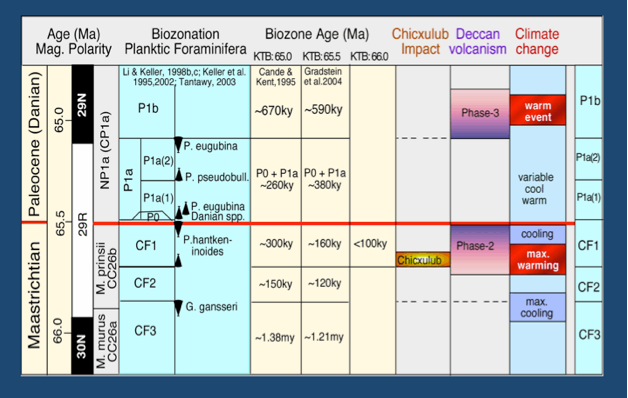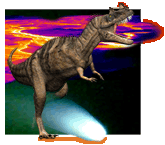
Figure 42. Planktic foraminiferal biostratigraphy, biozone ages calculated based on time scales where the KTB is placed at 65Ma, 65.5Ma and 66Ma, and the relative age positions of the Chicxulub impact, Deccan volcanism phases 2 and 3 and climate change, including the maximum cooling and maximum warming (greenhouse warming) and the Dan-2 warm event relative to Deccan volcanism.
Age Resolution — Relative Vs. Absolute Dating
Relative age dating is based on biostratigraphy (fossils: evolution and extinction of species, population acmes), isotope stratigraphy (characteristic global excursions) and magnetostratigraphy (magnetic reversals tied to biostratigraphy). What all of these dating techniques have in common is a reliance on fossils to place the chemo and magneto signals in the relative age because only extinctions and evolution the reliance on the principle of superposition, which simply means that in any normal sediment deposition the oldest layers are at the base and the younger layers successively deposit above. This is the basic principle of sedimentary geology. It is also the only way to evaluate a closely spaced sequence of events over a short time interval that is not resolvable with present dating techniques.
Absolute age dating is based on radiometric dating either by 40Ar/39Ar or U-Pb methods. These methods are based on the decay constant of gases. They provide actual age estimates in years but have a very large error margin of 1% for Ar/Ar dating, but can be much more accurate with U-Pb methods, which are a relatively recent development. All past dating techniques relied on K/Ar and Ar/Ar methods, which have large error margins exceeding the time resolution required to determine whether Chicxulub is KTB or pre-KTB age.
Here we summarize the history of Chicxulub age dating.
Most studies surrounding the Chicxulub impact crater have concentrated on the narrow interval of the sandstone complex or so-called impact-tsunami. Keller et al. (2002, 2003) placed that interval in zone CF1 based on planktic foraminiferal biostratigraphy and specifically the range of the index species Plummerita hantkeninoides that spans the topmost Maastrichtian. Zone CF1. The age of CF1 was estimated to span the last 300ky of the Maastrichtian based on the old time scale of Cande and Kent (1995) that places the KTB at 65Ma. The newer time scale (Gradstein et al., 2004) places the KTB at 65.5Ma, which reduces zone CF1 to 160ky.
By early 2000 our team embarked on an intensive search for impact spherules below the sandstone complex throughout NE Mexico. Numerous outcrops were discovered with impact spherule layers in planktic foraminiferal zone CF1 below the sandstone complex and we suggested that the Chicxulub impact predates the KTB by about 300ky (Fig. 42; Keller et al., 2002, 2003, 2004, 2005, 2007, 2009; Schulte et al., 2003, 2006).
Time scales change with improved dating techniques. Gradstein et al (2004) proposed to place the KTB at 65.5 Ma, (Abramovich et al., 2010). This time scale is now undergoing further revision (Renne et al., 2013) placing the KTB at 66 Ma, which reduces zone CF to less than 100ky. By this time scale, the age of the Chicxulub impact predates the KTB by less than 100ky based on impact spherule layers in the lower part zone CF1. See Fig. 42 for illustration.
At this time scale, the controversy over whether Chicxulub is precisely KTB age or predates the KTB by ~100ky cannot be resolved based on a single 40Ar/39Ar date, which has a 1% error due to argon gas loss, although it may be within the resolvable age by U-Pb dating. Age resolution of such short intervals can be resolved based on relative dating techniques using biostratigraphy, isotope stratigraphy, and magnetostratigraphy.
The age of the El Penon primary impact spherule layer can be estimated from biostratigraphy. The impact spherule layer is near the base of zone CF1, which spans 160ky based on the KTB at 65.5 Ma (Gradstein et al., 2004). This suggests that the impact occurred at about 130-150ky before the KTB mass extinction (Fig. 26). A new time scale being developed suggests that the KTB is at 66.0 Ma.
The pre-KTB age of the Chicxulub impact near the base of zone CF1 appears to be correlative with the early phase-2 of Deccan volcanism as well as the maximum warming (Fig. 42). The Deccan ending phase-3 in C29N appears to be correlative with the DAN-2 warm event (Keller et al., 2012).

